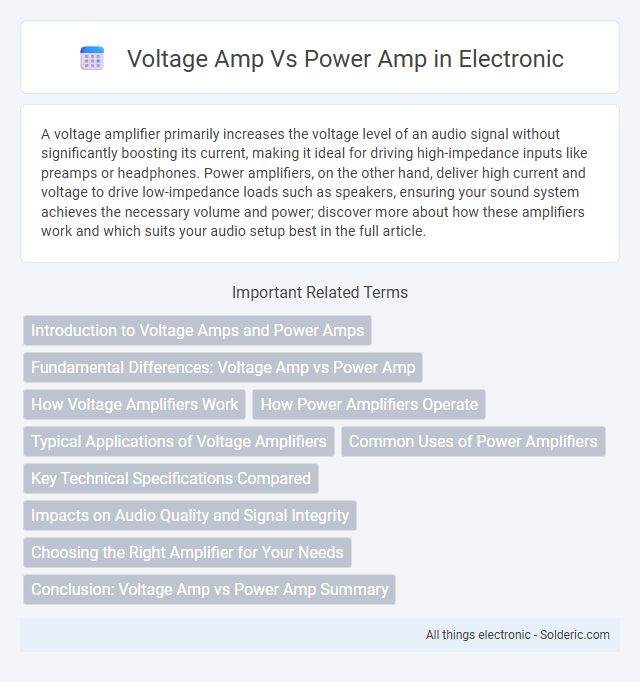A voltage amplifier primarily increases the voltage level of an audio signal without significantly boosting its current, making it ideal for driving high-impedance inputs like preamps or headphones. Power amplifiers, on the other hand, deliver high current and voltage to drive low-impedance loads such as speakers, ensuring your sound system achieves the necessary volume and power; discover more about how these amplifiers work and which suits your audio setup best in the full article.
Comparison Table
| Feature | Voltage Amplifier | Power Amplifier |
|---|---|---|
| Primary Function | Amplifies input voltage | Amplifies output power (voltage & current) |
| Output | High voltage, low current | High voltage, high current |
| Input Impedance | High input impedance | Varies, typically lower than voltage amp |
| Output Impedance | Relatively high | Low output impedance |
| Power Gain | Low to moderate | High |
| Typical Applications | Signal conditioning, preamplifiers | Driving speakers, power stages in audio |
| Common Classes | Class A, AB (for linearity) | Class AB, B, D (for efficiency) |
Introduction to Voltage Amps and Power Amps
Voltage amps are devices designed to boost the voltage level of an audio signal without significantly increasing its power output, making them essential for driving long cables and preserving signal integrity. Power amps, in contrast, amplify the electrical power of the audio signal to a level sufficient to drive loudspeakers and produce audible sound at higher volumes. Understanding the distinction between voltage amps and power amps helps you optimize your audio system for both signal quality and output strength.
Fundamental Differences: Voltage Amp vs Power Amp
Voltage amplifiers primarily increase the input signal's voltage without significantly boosting current, making them ideal for preamplification and signal conditioning. Power amplifiers are designed to deliver high current and voltage to drive loads like speakers, converting low-power signals into high-power output efficiently. Understanding these fundamental differences helps you choose the right amplifier type for your audio or electronic applications.
How Voltage Amplifiers Work
Voltage amplifiers work by increasing the amplitude of the input voltage signal while maintaining its original waveform, enabling better signal transmission and processing in electronic circuits. They achieve voltage gain through active components like transistors or operational amplifiers configured to amplify voltage without significantly increasing current. Your audio system benefits from voltage amplifiers by receiving a stronger signal that can be further boosted by power amplifiers for driving speakers effectively.
How Power Amplifiers Operate
Power amplifiers operate by increasing the power level of an audio signal to drive speakers with sufficient volume and clarity, converting low-voltage audio inputs into high-current outputs. They ensure efficient energy transfer and minimize distortion for optimal sound performance. Understanding how power amplifiers function helps you select the right equipment for your audio system's needs.
Typical Applications of Voltage Amplifiers
Voltage amplifiers are commonly used in audio equipment, instrumentation, and signal processing where precise voltage gain and signal integrity are crucial. In these applications, they ensure accurate amplification of low-level signals from sources like microphones or sensors without significantly increasing power output. Your audio devices benefit from voltage amplifiers to maintain signal clarity before the power amplifier stage boosts the signal for driving speakers.
Common Uses of Power Amplifiers
Power amplifiers are commonly used in audio systems to drive loudspeakers by boosting low-level audio signals to a level suitable for sound reproduction. They play a crucial role in public address systems, home theater setups, and musical instrument amplification, ensuring clear and powerful sound output. These amplifiers handle higher power loads compared to voltage amplifiers, making them essential for delivering strong and distortion-free audio in various amplification applications.
Key Technical Specifications Compared
Voltage amplifiers primarily focus on increasing signal voltage with high input impedance and moderate output current, making them ideal for processing weak audio or radio signals. Power amplifiers emphasize delivering high output current and low output impedance to efficiently drive speakers or other load devices, with wattage ratings often exceeding 50 watts. Your choice depends on whether you need signal amplification for precision or sufficient power to drive output devices effectively.
Impacts on Audio Quality and Signal Integrity
Voltage amplifiers primarily boost the input signal's amplitude without significantly increasing the current, preserving the audio signal's clarity and preventing distortion, which is crucial for maintaining high audio quality. Power amplifiers increase both voltage and current to drive speakers effectively, impacting signal integrity by ensuring sufficient power delivery but potentially introducing harmonic distortion if not properly designed. Your audio system benefits from a balanced use of voltage and power amps to achieve optimal sound fidelity and minimize degradation in the signal path.
Choosing the Right Amplifier for Your Needs
Voltage amps excel at boosting signal strength without significantly increasing power output, ideal for applications requiring precise control of audio signals. Power amps deliver greater wattage to drive speakers effectively, making them essential for high-volume sound reinforcement and large venues. Your choice depends on whether you need enhanced signal clarity or robust power to match your audio setup and environment.
Conclusion: Voltage Amp vs Power Amp Summary
Voltage amps focus on controlling signal voltage with high input impedance and low output impedance, ideal for driving preamps and line-level devices. Power amps amplify signal current to drive speakers, delivering high wattage and handling low-impedance loads efficiently. Your choice depends on whether you need voltage amplification for signal clarity or power amplification for speaker output strength.
Voltage amp vs Power amp Infographic

 solderic.com
solderic.com